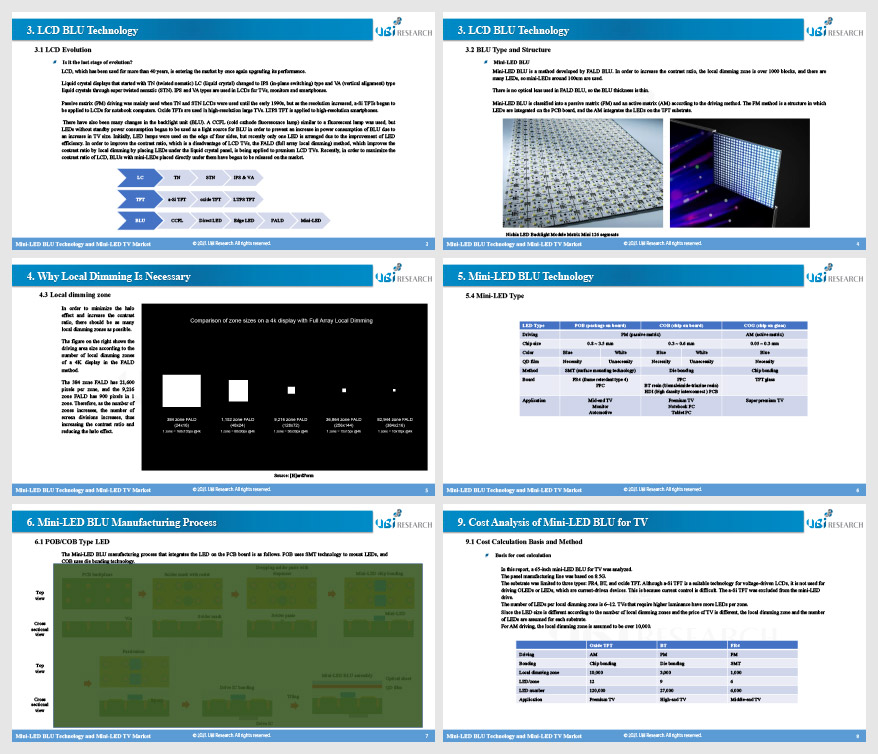Special Report
Mini-LED BLU Technology and Mini-LED TV Market
₩5,000,000
January 9, 2021
PDF(95P)Introduce
Products with more advanced LCDs appear. It is an LCD that has greatly improved brightness, HDR, and color reproducibility by adding QD film and mini-LED to BLU. The existing top-level LCD used a full array local dimming (FALD) BLU with a local dimming zone of about 300 to 500.
When the local dimming zone is increased to more than 3,000 by using mini-LED, the contrast ratio is significantly improved, and the halo effect is reduced compared to FALD BLU LCD TVs. In order to realize the same performance as OLED, the local dimming zone must have as many pixels as the number of pixels, but due to the limitation of LED size reduction, mini-LED TVs to be sold this year will have a local dimming zone of 1,000 to 3,000 products. Driving is a PM method.
A TFT substrate is required for AM driving. It is still under development, and oxide TFT and LTPS TFT are expected to be used.
UBI Research prepared this report, expecting that mini-LED TVs will compete in picture quality with OLED TVs in the future and will grow rapidly.
This report consists of three parts: technical content related to mini-LED BLU, mini-LED TV market forecast through cost analysis, and supply chain.
The mini-LED BLU technology, development status, and mini-LED BLU business feasibility are easy to understand.
Contents
1. Outline
2. Competition Between LCD and OLED
2.1 Limitations of LCD and Advantages of OLED
2.2 OLED’s Dominating Premium TV market and LCD’s Survival Strategy
3. LCD BLU Technology
3.1 LCD Evolution
3.2 BLU Type and Structure
3.3 The Latest Trends in BLU of Set Makers
4. Why Local Dimming Is Necessary
4.1 Why Local Dimming is Necessary
4.2 Local Dimming and Halo Effect
4.3 Local Dimming Zone
5. Mini-LED BLU Technology
5.1 Why We Need a Mini-LED Backlight
5.2 BLU Structure and Thickness Comparison
5.3 LED Size
5.4 Mini-LED Type
5.5 Backplane Type
6. Mini-LED BLU Manufacturing Process
6.1 POB/COB Type LED
6.2 COG Type LED
7. Mini-LED TV Exhibition Trend
7.1 TCL
7.2 LG Electronics
7.3 Changhong
7.4 BOE
8. Mini-LED Application
8.1 Mini-LED TV
8.2 Mini-LED Monitor & Notebook
9. Cost Analysis of Mini-LED BLU for TV
9.1 Cost Calculation Basis and Method
9.2 65-inch Mini-LED BLU Cost Analysis
10. Mini-LED TV Market Forecast
10.1 Mini-LED TV Price Prospect
10.2 Set Makers’ Mini-LED TV Sales Strategy Analysis
10.3 Mini-LED TV Market Forecast
10.4 Mini-LED TV and OLED TV Competition
11. Mini-LED BLU Supply Chain
11.1 Supply Chain
11.2 Supply Chain by Company
11.3 Mini-LED BLU Related Companies
Report Sample
Previous Report Status
Related Products
-

2024 OLEDoS Industry and Technology Report
₩0October 30, 2024
PDF(155p)This report is centered around OLEDoS (Organic Light Emitting Diode on Silicon) technology, providing a comprehensive analysis of XR devices, market conditions, industry trends, and key manufacturing and technical issues. It covers the current state of product development, major technological challenges, supply chain analysis, and essential materials. The report highlights the latest trends in the XR market and underscores the critical role OLEDoS plays in XR devices, offering a detailed analysis of key technologies and material advancements.
OLEDoS combines the advantages of both LCoS and LEDoS while addressing their limitations, making it the most promising micro-display technology for XR devices due to its scalability for mass production. The report thoroughly outlines the significant technical issues associated with OLEDoS and includes research trends aimed at solving these challenges.
The success of the OLEDoS industry hinges on strong collaboration between the supply chain, manufacturers, consumers, and research institutions. This report is designed to offer valuable insights into the cooperative efforts necessary to drive success in the OLEDoS sector. -

Micro-LED Display Technologies for XR Applications
₩0January 22, 2025
PDF(109p)Micro-LED display is gaining attention as a next-generation display after OLED display. Surely before commercialization, there are several improvements required on manufacturing processes, production costs, full-color implementation, and yield management.
-

2025 Automotive Display Technology and Industry Trends Analysis Report
₩0February 18, 2025
PDF(217P)The automotive industry is undergoing rapid transformation beyond mere mechanical innovation, entering the era of Software-Defined Vehicles (SDVs). As autonomous driving technology and electric vehicle advancements accelerate, cars are evolving from simple transportation tools into smart devices centered around user interaction.


